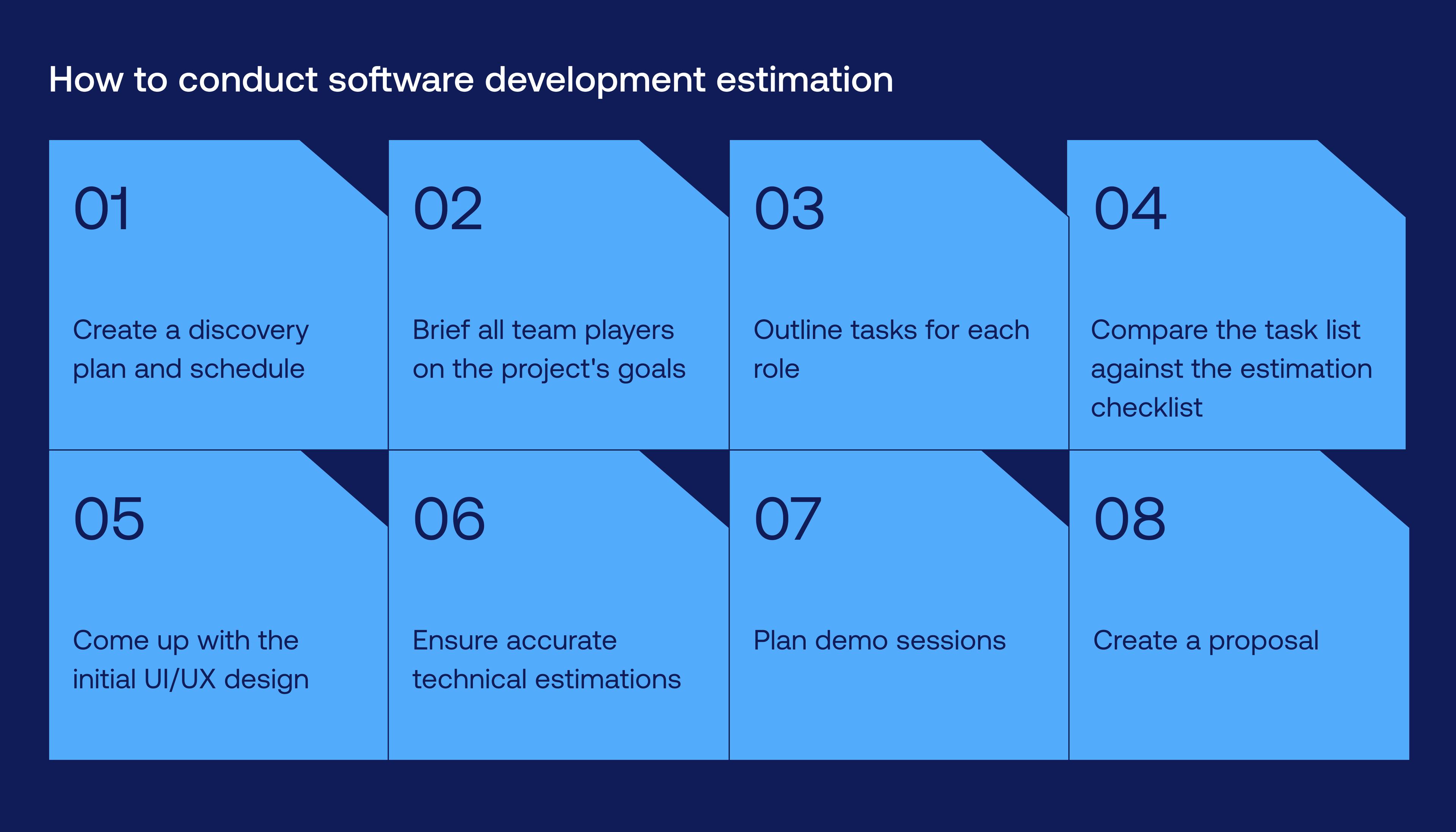
A practical guide to software development estimation



Key takeaways
-
Expert project estimation is critical for your project's success. It involves not only understanding the scope, but also strategies for effectively distributing resources and managing potential risks.
-
You can access various estimation techniques, including analogous estimation, expert judgment, and bottom-up methods. Each can be tailored to meet the specific needs and resources of your project, ensuring a perfect fit for your unique requirements.
-
Our engineering managers stress the importance of incorporating consistent feedback and promptly communicating any changes during the estimation process. This approach is key to a flexible and forward-thinking strategy, particularly crucial in the dynamic environment of startup software development.
Grappling with projects that consistently miss their mark in time, budget, and scope due to unreliable estimations? Finding it tough to efficiently allocate and manage resources, leading to team burnout and stakeholder dissatisfaction? Is inaccurate software development estimation causing quality trade-offs, slow decision-making, and a dent in your competitive edge?
You're not alone: Only 16.2 percent of software projects are completed without overshooting resource limits. (Ouch. We know.) The good news? With our tried-and-true estimation techniques, you can buck the trend and set your projects up for success.
Frequently involved in client project estimations, our team excels in identifying and deploying the necessary resources to realize diverse project visions. We’re proficient in anticipating and addressing project hurdles, ensuring our estimates cover the entire scope. Yes, even if the project evolves or changes down the line.
With countless estimations under their belt, our expert engineering managers, Alexander Skomyanov and Vlad Antsipin, share everything they know about crafting effective and accurate estimates. Join them to learn how strategic evaluation is crucial for accurate project planning and delivering superior outcomes in quality, time management, and software development costs.
Software development estimation: Basics you should know
It all starts with a discovery phase
The essence of software development estimation lies in its ability to forecast the cost of a project and the time needed to meet objectives. Yet, its significance extends beyond just numbers; for us, this phase serves as a crucial juncture to thoroughly align with the client’s needs.
Software development estimation occurs during the discovery phase, where stakeholders gather essential information about the project’s vision, industry, objectives, and requirements.
This process encompasses evaluating both functional (specific behaviors or functions of the system) and non-functional requirements (overall characteristics such as security, usability, and reliability), along with grasping customer expectations and the target audience's needs. Next, the project undergoes task decomposition (read: description), project time estimation, and resource planning.
The ultimate goal of these steps is to provide stakeholders with a clear understanding of the investment required to successfully deliver the project before initiating development.
In a nutshell, software project estimation helps to:
- Set specific goals for the project
-
Gain an in-depth understanding of all project requirements
-
Come up with a detailed scope of work and timelines for software implementation
-
Assemble an efficient project team
-
Provide an accurate software development cost estimation
Discovery phase deliverables
The discovery phase brings together tech specialists, project managers (PM), business analysts (BA), and designers, whose collaborative output results in a set of deliverables that play a key role in guiding the next stages of software development estimation and project planning.
Note that each deliverable is a foundational input for the succeeding step and, therefore, cannot be overlooked.
Discovery phase deliverables
|
Team member |
Key results |
|
Project Manager (PM)/ Business Analyst (BA) |
|
|
Design team |
|
Quality Assurance (QA)/ security/BA/PM |
|
Project Manager |
|
Why is software development estimation crucial?
We all know that the startup world is tough. According to Failory, the success rate for startups is only about 10 percent, with a staggering 90 percent encountering failure, often due to poor planning.
Fortunately, there is a clear path to avoid the pitfalls of inaccurate software estimation. At the outset of the discovery phase, implement a structured, three-step product design process: define the problem, develop the solution, and, finally, validate the solution. This strategy helps in fully understanding the project's scope and offers a step-by-step guide from pinpointing the initial problem to developing and then validating the solution, guaranteeing a well-planned and successful outcome, particularly for startups.
This approach helps answer key questions:
-
Is the business idea viable? Is it worth implementing?
-
What should be the core features of the product? Is there a need for advanced features using AI/ML, IoT, or blockchain technology?
-
Do you need to go for a mobile app, a web app, or both?
-
Which tech tools should you stack up? How crucial is it to have a responsive design?
-
What software development team members are required for your project?
-
How long will it take to implement your project?
-
What will be the final estimated cost?
Having well-thought-out answers to these questions will help you:
-
Develop a comprehensive plan with organized and prioritized tasks
-
Efficiently allocate resources based on software development time estimation
-
Build effective communication between developers and project managers, leading to improved collaboration and better decision-making
-
Improve team morale by promoting ownership and accountability, as team members play a part in determining task efforts

How to accurately estimate your project: techniques and strategies
We've covered all the 'whys.' Now, onto the 'hows.' Our experts, Vlad and Alex, have shared their insights and recommendations on when to employ specific strategies of time estimation for your project.
Analogous estimation
The estimation by analogy involves comparing similar past projects to the present one. First, you pinpoint previous projects that closely match the current tasks, then use the data from these past projects to estimate the effort needed for what you do now.
Perfect when: You have a consistent team working on the same project within a specific timeframe. However, as our experience has repeatedly demonstrated, this approach often falls short in practical application, as each business project typically has its unique requirements.
Expert judgment / Planning poker
The expert judgment estimation technique involves a team of experienced professionals that evaluate project size based on their collective expertise (particularly useful when project details are scarce). The final estimate is formed by engaging in meaningful discussions and applying comparative analogy, tapping into the rich experience of all stakeholders.
Perfect when: Your resources enable complete team engagement in the estimation process, increasing their accountability. While it’s safe to say that you’ll spend more time on detailed discussions, this approach significantly improves estimate precision. It's well-suited for those focused on precise budgeting and timelines while enhancing team responsibility.
Bottom-up estimation
In this approach, the team breaks down a project into smaller, more manageable tasks and subtasks, enabling clear definition and effective oversight. This segmentation simplifies the estimation process for individual tasks.
And while aggregating estimates in software development from the bottom to the top may be time-consuming, it results in a more accurate overall estimation.
Perfect when: You have enough time and resources at your disposal. Consider also complementing this approach with similar techniques to maximize effectiveness, especially if you prioritize efficient budget and timeline management.
Top-down estimation
Alternatively, top-down estimation involves an initial project scope assessment, followed by identifying crucial tasks. The next step is to estimate software development time separately, allowing for a more comprehensive understanding of the project's broader requirements and facilitating strategic resource allocation.
Perfect when: You’re in the early phases of a project, as this approach offers a time-saving solution over bottom-up methods and pairs well with expert judgment estimation techniques.
Three-point estimate / PERT chart
This technique forecasts the time required for project completion by considering the best, worst, and most probable scenarios. Development time is generally calculated using three values: optimistic (O), pessimistic (P), and most likely (M), averaging them with the formula: PERT Estimate = (O + 4 x M + P) / 6.
Perfect when: You have additional time per the bottom-up estimation — especially if there's a significant gap between the pessimistic/optimistic/most likely scenarios. This time estimation technique is especially helpful if your team struggles to identify risks as separate activities from the main task.
What-if analysis
It’s a crucial tool for understanding how any future changes in the project’s scope may impact the project's timeline, effort estimation, resources, and software development costs. This analysis of hypothetical situations informs decision-making, enhances planning precision, and promotes project success.
Perfect when: You want this technique to complement other methods for greater accuracy and better risk management.
T-shirt estimate
T-shirt sizing is a flexible estimation technique employed by agile teams to evaluate user stories (which describe features from a user's perspective), as well as plan and prioritize development work. By evaluating how challenging each story is, teams can better allocate time and resources.
The T-shirt sizing method simplifies this assessment by categorizing stories into size categories (XS, S, M, L, XL, XXL) based on their relative complexity or effort required, instead of assigning precise numerical values. This approach allows for a more intuitive and flexible way to gauge the workload and complexity of each task, helping the team to manage their workflow and set realistic expectations.
Perfect when: It's used in tandem with the top-down method and expert judgment for a more comprehensive software development estimation process.
Vention's special startup estimation technique
Leveraging our substantial experience working with tech startups, we've developed a unique method for estimating software projects. This technique is tailored to help you assess your project's viability and understand the required efforts from the get-go.
In this process, we guide emerging businesses in identifying their likely tech stack, implementation strategies, team size, and approximate costs in a concise format, without delving into granular details. In case you require a more comprehensive evaluation of your business goals, we can combine this method with other estimation approaches.
Perfect when: You're seeking swift, straightforward estimations vital for initial business decisions. Our method is especially effective during the early stages, such as the proof of concept (POC) phase.
Got a business idea and need accurate project estimation for its execution?
Connect with our specialists, who will craft an action-ready estimate, enabling you to complete your project on time, on budget, and on scope.
The process of software development estimation
Our leading engineering experts suggest a series of specific steps to effectively estimate software development cost and assess the necessary efforts and time for successful project completion.

1. Create a discovery plan and schedule
For a successful discovery phase, a project manager should craft a thorough discovery plan and establish a structured schedule. This step is the first building block for estimating software development costs accurately and figuring out how long the discovery phase will take — not to mention it efficiently coordinates pre-sale and project activities.
2. Inform each team member about the project’s objectives
Before diving into the discovery phase, designers and developers need a comprehensive understanding of the business idea. This clarity can be provided by the PM or BA, who — after an initial few weeks of collaboration — will outline specific technical tasks for the team.
3. Outline tasks for each role
This involves preparing a document that lists task decomposition, estimates, and implementation descriptions for each type of specialist in the project. Note that the document should detail tasks for each role but doesn't yet define the project's total duration.
4. Ensure the task list covers all aspects of software estimation
The project manager creates a comprehensive task breakdown, ensuring the team has ticked every box in the estimation checklist. This thorough process minimizes risks and enhances the project's overall success.
5. Come up with the initial UI/UX design
Create comprehensive UI/UX designs that outline screen components, user behavior, and transitions. If your application doesn’t need UI/UX, engineers can conduct a similar process by reviewing the APIs and interfaces of your future project.
6. Ensure accurate technical estimations
Leveraging design prototypes and in-depth requirements, developers fine-tune technical estimates, dedicating at least four hours daily. This stage ensures realistic estimates, including all stages from environment setup and (if needed) CI/CD configurations to final software testing and demos.
7. Plan demo sessions
During this phase, PMs or BAs meticulously plan demo scenarios, factoring in time for feedback after each session. QA engineers are briefed in detail about the demo's content and sequence, which ensures focused quality assessment — crucial for the success of each demonstration.
8. Сreate a proposal
After gathering estimates from all involved experts, the PM assembles a detailed proposal. This includes a well-organized presentation, a breakdown of tasks with associated timelines, and a projected budget. The PM then presents this comprehensive proposal to key stakeholders, ensuring the delivery is clear and professional.
Extra tips from our experts:
1. Achieving task success requires accurately determining their sequence. Tools like Gantt Charts can be helpful in outlining the project timeline, allowing for a clear visualization of each phase and its dependencies. This clarity aids in preemptively identifying potential bottlenecks and streamlining the workflow.
2. To manage team performance more efficiently, try incorporating sprints and demo sessions into the project's timeline. Splitting the project into sprints and wrapping each with a demo allows for regular assessments against the original plan.
3. The ongoing process of reviewing and optimizing the designs and screen integrations during the development stages is vital for effectively displaying each sprint's UI/UX aspects. This contributes to refining the development process and ensures a consistently smooth delivery.
Common software development estimation mistakes and how to avoid them
Numerous elements influence a project's trajectory, many of which can be managed to prevent potential complications. Here are our tips to help you steer clear of these obstacles and achieve a smooth project execution.
Missing elements from the project scope
Occasionally, estimates might miss specific UI/UX components like password recovery flows on login pages, account deletion options in profiles, or extra quality checks during the development phase.
Solution:
Consider holding additional workshops or sessions with UI/UX designers, developers, project managers, and key stakeholders for further scope validation. These sessions are designed to align and cultivate a collective vision, guaranteeing a unified agreement on the project's scope.
Improper management of change requests
Effectively managing change requests (CRs) from stakeholders can be a complex task, particularly in the midst of intense project stages. Even what appears to be simple code changes can potentially impact other parts of the application — especially if there is existing technical debt.
Solution:
It is crucial for the team to quickly identify and communicate any change requests as they occur. The standard procedure for managing CRs is as follows:
-
A team member notifies the PM or BA about the CR.
-
PM or BA conducts a pre-check to validate the CR and formulates it for business stakeholders.
-
The CR is then presented to the business stakeholders to evaluate its urgency and importance.
-
The PM or BA assigns resources to assess the CR and drafts a timeline for its resolution.
-
A major stakeholder approves the proposal.
A useful note: The PM or BA may require up to four hours per day to process CRs, and this duration could vary depending on the project's complexity.
Inaccurate estimation of bug-fixing tasks
Bug-fixing remains a tricky area in work estimation. It's a prime example of a task where multiple factors intersect: pressing deadlines, possible additional tasks, and the solution's inherent complexity.
This often leads to technical debt accumulation and, as a result, an increased volume of bugs requiring resolution. Recognizing and grasping these intricacies is essential for effectively managing and prioritizing bug-fixing tasks.
Solution:
To effectively manage this type of work, consider one of the following techniques:
1. Set aside around 30 percent of the development estimate for bug fixes (may vary depending on the project’s domain and complexity). Initially, the predicted number of bugs tends to be lower, while towards the end, it typically increases.
2. Set aside some development work for bug fixes when QA testing begins, aiming for an estimate as close to reality as possible. The result will be a timely deployment of additional development resources.
To facilitate smooth collaboration between developers and QA engineers during bug-fixing, a practical rule is half a day of development work for each full QA day. This ensures frontend developers begin fixing issues in sync with QA testing, with backend developers joining as required.
Note that this method provides only a general framework, so our experts are dedicated to tailoring the estimates to fit the individual nuances and requirements of your specific project.
Estimating time for meetings and communication
Accounting for team size is essential from the start, as it significantly influences the need for coordination and communication. The rule of thumb? The bigger the team, the greater the time investment in communication and meetings.
Solution:
You can choose one of these effective time management strategies for teams with five to 15 members:
1. Allocate an additional 15 percent of the time for communication. This simple step is crucial for understanding the project's real-time progress.
Bear in mind that developers primarily focus on engineering tasks and may have limited availability for communication. It's crucial to realistically assess and not overestimate time for their communication in your planning.
2. Dedicate 15-60 minutes daily for team-wide meetings to ensure everyone is on the same page. Plus, set aside 30-120 minutes daily for PMs and BAs to interact with stakeholders, bolstering communication efficiency. This approach seamlessly integrates with the previously mentioned strategy, further refining the estimation process.
3. For teams of four to 10 members, it's advisable for the team lead to spend about 60 minutes daily resolving technical issues. Additionally, dedicate 60-180 minutes to handle pull requests and perform code reviews, which will enhance project quality and coordination.
Our approach to project estimation
Backed by over 20+ years’ of expertise in engineering, Vention’s team has honed an established software development estimation process that centers around the discovery phase. This involves meticulously exploring customer projects, breaking them into phases, and engaging various team members and stakeholders, including BAs, PMs, developers, designers, and QA professionals.
By engaging such a wide range of expertise early on, we ensure a comprehensive understanding of each client's unique needs, leading to more accurate estimates that effectively mitigate potential risks and comply with the distinct technical specifications and time limitations of each project.
Looking for a straightforward estimate? We offer an estimation strategy tailored to your unique business requirements. If you prefer a detailed insight into specifications and screen designs, our product discovery workshops (PDWs) are the way to go. (PDWs are especially great for non-technical clients seeking software cost estimation without getting into the nitty-gritty of coding.)
If a project is short-term and comes with comprehensive task breakdowns and estimates from the entire team, we provide a detailed timeline estimation. Developed post-discovery, this estimation mirrors the actual development process and includes bug fixing, backend support during frontend development, preparation and execution of demo sessions, and handling any emerging CRs.
Whichever software estimation route you select with us, one thing remains unchanged: our unwavering commitment to clear communication and exceptional quality. We help our clients avoid unrealistic expectations and misunderstandings, fostering an open and collaborative relationship. Need proof? Our clients’ testimonials on Clutch.co say it all about our successful development estimates.
“We were very happy with the initial specification, the design prototypes, and the accuracy of time estimates on the sprints. The app was completed, and we decided to continue the relationship. The app is still in beta mode however, we are well on the way to the 2.0 release.”

“I found them to be professional, fast, and realistic. The team gave us accurate estimates, and were helpful in situations when we didn’t know how to best display something. Instead of only building what they were hired to build, both engineers from Vention’s team brainstormed solutions which went beyond the official scope of their duties.”
Looking for a team of experts to accurately estimate your project development?
Vention’s team can provide you with a clear project scope, budget planning, a realistic timeframe, and a detailed risk assessment.





